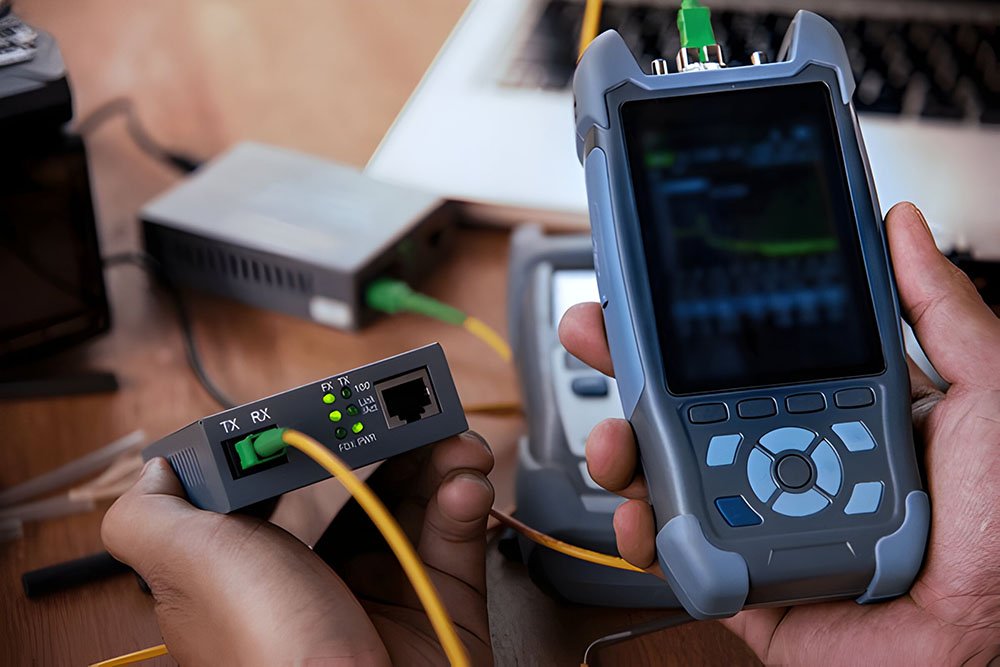Imagine G657A1 vs G657A2 vs G652D as a trio of runners gearing up for different races—one’s a marathon champ, another’s a sprinter weaving through city streets, and the third’s an acrobat flipping through tight corners. These aren’t just techy codes; they’re fiber optic standards set by the International Telecommunication Union (ITU), defining how glass fibers carry light signals across vast distances or cramped spaces. Whether you’re rigging up a rural broadband network, wiring a high-rise apartment, or linking a data center’s servers, choosing between G657A1, G657A2, or G652D is like picking the perfect tool for the job.
In this deep dive, we’ll explore G657A1 vs G657A2 vs G652D—their specs, strengths, and sweet spots. Think of it as test-driving cars: you need the right horsepower and handling for your road. We’ll cover what they are, where they excel, how they bend, cost, and more, all with a nod to CommMesh’s high-quality offerings. By the finish line, you’ll know which fiber suits your project—whether it’s a long haul or a tight squeeze. Let’s hit the track and break it down!
What Are G657A1 vs G657A2 vs G652D Fiber Standards?
The G657A1 vs G657A2 vs G652D lineup is like a family of fiber optic blueprints—each crafted with a purpose, balancing performance and practicality. These ITU standards dictate how fibers handle light, bending, and signal integrity, shaping their role in modern networks.

G652D: The Classic Long-Distance Star
- Definition: The granddaddy of single-mode fibers, G652D debuted decades ago and remains a telecom staple. It’s the “D” variant—low water peak (LWP)—meaning it minimizes signal loss from water absorption in the glass.
- Specs: 8-10 micron core, 125 micron cladding, optimized for 1310 nm and 1550 nm wavelengths.
- Role: Built for endurance—like a marathon runner pacing steady over miles.
G657A1: The Bend-Friendly Middle Child
- Definition: An evolution of G652D, G657A1 is bend-insensitive, introduced to handle modern, twisty setups without losing signal. It’s part of the G657 family, with “A1” marking its first tier.
- Specs: Same 8-10 micron core, but engineered to flex without breaking the light’s stride.
- Role: A sprinter dodging urban obstacles—flexible yet fast.
G657A2: The Bend-Proof Prodigy
- Definition: The top-tier G657 variant, G657A2 takes bend-insensitivity to the max, designed for the tightest spaces where fibers twist like pretzels.
- Specs: 8-10 micron core, ultra-low bend loss—think acrobat-level agility.
- Role: The go-to for cramped, high-density networks.
CommMesh stocks all three—G652D for traditional runs, G657A1 for versatile bends, and G657A2 for extreme twists.
Applications of G657A1 vs G657A2 vs G652D
Each G657A1 vs G657A2 vs G652D fiber has its playground—like athletes picking their turf. Let’s map out where they thrive, with real-world examples to flesh it out.

G652D Applications
- Where: Long-haul telecom networks, internet backbones, rural FTTH deployments.
- Why: It’s built for distance—low attenuation (0.2 dB/km at 1550 nm) keeps signals strong over kilometers. It’s the backbone of global connectivity, linking continents via undersea cables or stretching across plains.
- Examples: A telecom company uses G652D to connect two cities 50 km apart, or a rural ISP deploys it for FTTH over 20 km stretches with minimal repeaters.
- Fit: Straight, open paths where bending’s rare.
G657A1 Applications
- Where: Urban FTTH, office buildings, campus networks with moderate twists.
- Why: Its bend radius (10-15 mm) handles corners without signal hiccups—perfect for city wiring where cables snake through walls or ducts. It balances distance and flexibility.
- Examples: An apartment complex runs G657A1 from a street cabinet to units, bending around tight stairwells, or a university links dorms 5 km apart with some curves.
- Fit: Moderate density, some bending needed.
G657A2 Applications
- Where: High-density FTTH drops, data centers, indoor networks with sharp turns.
- Why: With a 7.5 mm bend radius, it’s the king of tight spaces—signal loss stays tiny (0.1-0.2 dB per turn) even in cramped setups. It’s ideal where space is gold.
- Examples: A flat drop cable uses G657A2 to twist from a pole into a home, or a data center squeezes it between server racks with hairpin bends.
- Fit: Ultra-dense, bend-heavy zones.
CommMesh’s G652D powers long runs, while our G657A1/A2 cables flex for FTTH—stocked and ready.
Bending Performance in G657A1 vs G657A2 vs G652D
Bending’s the headline act in G657A1 vs G657A2 vs G652D—like a flexibility contest. Here’s how they stretch and bend without snapping the signal.

G652D Bending
- Radius: 30 mm minimum—stiff as a plank.
- Loss: Bend it tighter, and loss spikes—1-2 dB or more, killing signal quality fast.
- Details: It’s designed for straight shots—think highways, not alleys. Push it too far, and light scatters like a spilled drink.
- Fit: Long, open runs—no sharp corners allowed.
G657A1 Bending
- Radius: 10-15 mm—twice as flexible as G652D.
- Loss: Low at 0.2-0.5 dB per tight turn—holds up under moderate stress.
- Details: It’s engineered with a bend-insensitive coating, letting light stay on track even in curves. Perfect for urban wiring where ducts twist.
- Fit: City networks, some bending required.
G657A2 Bending
- Radius: 7.5 mm—half G657A1’s limit, acrobat-level agility.
- Loss: Barely 0.1-0.2 dB per turn—near bulletproof signal retention.
- Details: Advanced design traps light tighter, thriving in the tightest spots—like coiling around a pencil without a blink.
- Fit: High-density setups, extreme bends.
G652D’s rigid—G657A1/A2 bend like pros, with A2 stealing the show.

Cost Comparison of G657A1 vs G657A2 vs G652D
The G657A1 vs G657A2 vs G652D price is like a grocery list—staples are cheap, specialties cost more. Here’s the rundown:
G652D Cost
- Range: $0.05-$0.10 per meter—lowest of the pack.
- Why: It’s the oldest, most produced single-mode fiber—mass manufacturing keeps it lean. No fancy bend tech here.
- Details: Widely available, used in bulk for telecom—think buying rice in sacks.
- When: Budget-friendly long-haul runs.
G657A1 Cost
- Range: $0.08-$0.15 per meter—mid-range step-up.
- Why: Bend insensitivity adds manufacturing complexity—special coatings and tighter tolerances bump the price.
- Details: Costs more than G652D but less than A2—balanced value for flexibility.
- When: Urban projects need some bend without breaking the bank.
G657A2 Cost
- Range: $0.10-$0.20 per meter—premium tier.
- Why: Extreme bend performance demands advanced materials and precision—think artisanal bread vs. store-bought.
- Details: Priciest but worth it for high-density needs where every turn counts.
- When: Dense FTTH or data centers.
CommMesh offers G652D for thrift, G657A1 for value, G657A2 for top flex.
Compatibility and Splicing in G657A1 vs G657A2 vs G652D

How G657A1 vs G657A2 vs G652D team up—like puzzle pieces fitting together—matters for upgrades or repairs. Here’s the lowdown:
G652D Compatibility
- Fit: Perfect with legacy G652 networks—splices like butter with itself.
- Splice Loss: 0.02-0.05 dB—super low, seamless joins.
- Details: It’s the standard others match to—ubiquitous in older telecom grids.
- Catch: Slight core mismatch with G657—needs tweak for A1/A2.
G657A1 Compatibility
- Fit: Backward-compatible with G652D—ITU designed it that way.
- Splice Loss: 0.05-0.1 dB with G652D—slightly higher but workable.
- Details: Core’s close enough, but refractive index differs—modern splicers handle it fine.
- Catch: Precision needed—sloppy work ups loss.
G657A2 Compatibility
- Fit: Works with G652D and G657A1—versatile bridge.
- Splice Loss: 0.05-0.1 dB—matches G657A1’s slight bump.
- Details: Tighter bends don’t affect splicing—same core size, just bendier guts.
- Catch: High-end splicers shine here.
CommMesh’s G657A1/A2 cables splice smoothly with G652D—future meets past.
Performance Over Distance in G657A1 vs G657A2 vs G652D
Distance is the endurance test for G657A1 vs G657A2 vs G652D—like a runner’s stamina. Here’s how they fare:
G652D Distance
- Range: 40 km+—marathon gold.
- Attenuation: 0.2 dB/km at 1550 nm—signal stays crisp.
- Details: Optimized for long-haul—low dispersion, low loss. It’s the go-to for telecom giants like AT&T or Verizon.
- Fit: Cross-country or rural links.
G657A1 Distance
- Range: 20-40 km—still strong, less reach.
- Attenuation: 0.2 dB/km—equals G652D’s loss rate.
- Details: Bend focus doesn’t hurt distance much—great for city-to-suburb runs with some turns.
- Fit: Urban FTTH, campus spans.
G657A2 Distance
- Range: 10-20 km—shortest but sharp.
- Attenuation: 0.2 dB/km—same low loss.
- Details: Trades range for bend prowess—best in dense zones, not vast stretches.
- Fit: Local high-density networks.
G652D’s the distance king—G657A1/A2 flex closer to home.

Future-Proofing with G657A1 vs G657A2 vs G652D
Choosing G657A1 vs G657A2 vs G652D is like planting a garden—think years ahead. Here’s the forecast:
G652D Future
- Pros: Proven for long-haul—still vital for telecom grids.
- Cons: Bend limits lag as networks densify—5G and smart cities need more.
- Details: Solid for rural or legacy, but urban growth outpaces it.
- Fit: Stable, less dense futures.
G657A1 Future
- Pros: Bend-ready for growing cities—versatile middle ground.
- Cons: Not the tightest for ultra-dense trends—G657A2 edges it out.
- Details: Handles FTTH boom well—think expanding suburbs or mid-rise builds.
- Fit: Balanced growth plans.
G657A2 Future
- Pros: Bend master—built for 5G, IoT, dense urban sprawl.
- Cons: Overkill for straight, sparse runs—costlier upfront.
- Details: Matches future high-density demands—apartments, smart grids.
- Fit: Cutting-edge networks.
G657A2’s the future MVP—CommMesh has it locked in.
Comparing G657A1 vs G657A2 vs G652D
Here’s a G657A1 vs G657A2 vs G652D cheat sheet—like a race recap:
| Fiber Type | Bend Radius | Distance | Cost ($/m) | Best For |
|---|---|---|---|---|
| G652D | 30 mm | 40 km+ | $0.05-0.10 | Long-haul, telecom |
| G657A1 | 10-15 mm | 20-40 km | $0.08-0.15 | Urban FTTH, offices |
| G657A2 | 7.5 mm | 10-20 km | $0.10-0.20 | Dense FTTH, data |
Your roadmap—match bend, range, and budget.
Why Choosing the Right G657A1 vs G657A2 vs G652D Matters
Picking the right G657A1 vs G657A2 vs G652D is like choosing boots for a trek—wrong pair, and you’re hobbling. G652D shines on long, straight trails but stumbles in tight urban twists. G657A1 navigates city paths with ease, while G657A2 conquers the densest jungles. A mismatch—like G652D in a cramped flat—means signal loss or wasted fixes; overkill with G657A2 on a rural line burns cash. The right choice keeps data fast, costs smart, and your network future-proof—ITU standards back it up.
Conclusion: G657A1 vs G657A2 vs G652D Made Clear
The G657A1 vs G657A2 vs G652D showdown comes down to your race—G652D for marathon hauls, G657A1 for urban sprints, G657A2 for tight acrobatics. CommMesh delivers all three—G652D for classics, G657A1/A2 for FTTH, shipping in 7 days. Whether you’re unraveling fiber optic standards or hunting the perfect fiber, visit CommMesh to grab yours. Keep your network swift and smart—pick the winner today!

